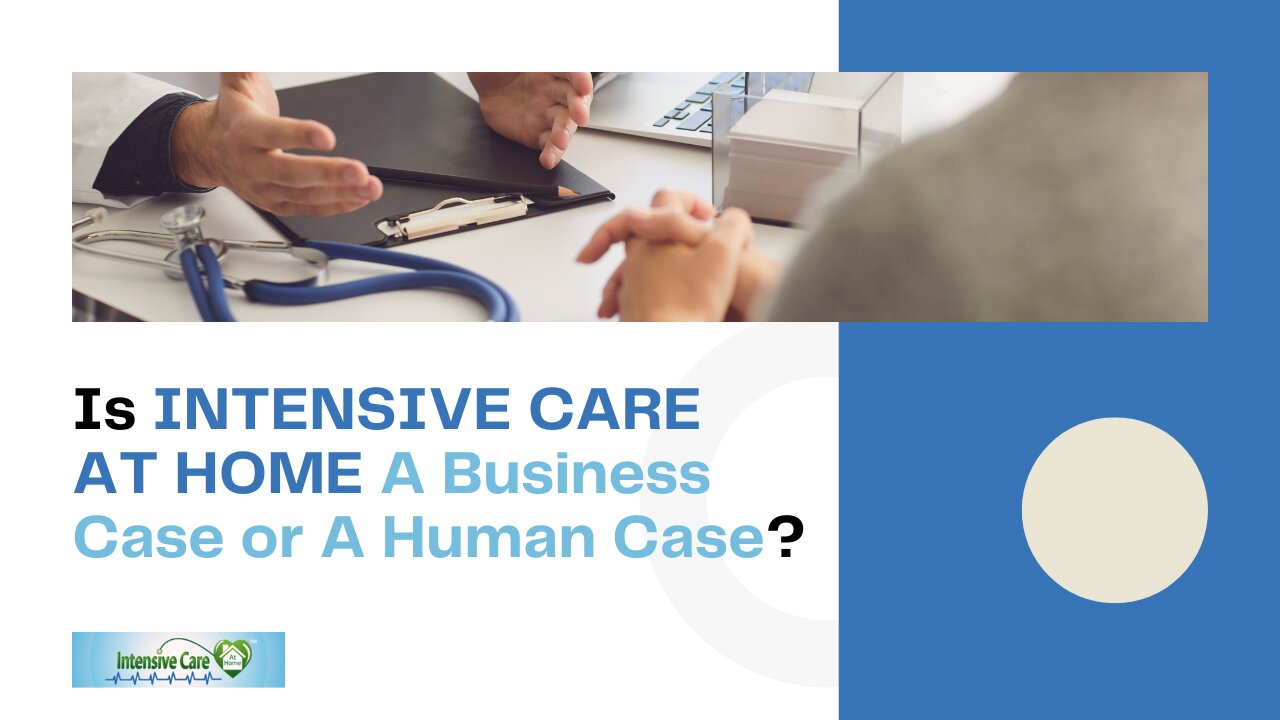Premium Only Content

Is INTENSIVE CARE AT HOME A Business Case or A Human Case?
https://intensivecareathome.com/is-intensive-care-at-home-a-business-case-or-a-human-case/
Is INTENSIVE CARE AT HOME A Business Case or A Human Case?
Book your free 15-minute phone consultation here
http://intensivecarehotline.com/scheduling-appointment/
Call directly 24/7
+1 415-915-0090 USA/Canada
+44 118 324 3018 UK
+6141 094 2230 Australia
Email support@intensivecarehotline.com
Get 1:1 consulting and advocacy
1:1 phone counselling
http://intensivecarehotline.com/one-on-one-counselling/
Become a member for families of critically ill Patients in Intensive Care
https://intensivecarehotline.com/intensivecaresupport-org-membership/
Immediate action steps http://intensivecarehotline.com/take-control-take-charge/immediate-action-steps/
https://intensivecareathome.com
And if you need a medical record review, click on the link and we can help you with reviewing your loved one’s medical records while they’re in ICU.
https://intensivecarehotline.thrivecart.com/review-of-medical-records/
Facebook Page: https://www.facebook.com/ICUhotline
Twitter: https://twitter.com/icuhotline
Song: Jarico - Island Music
supported by@FreeBackgroundMusicForCreators
#BackgroundMusicWithoutLimitations
https://bit.ly/2XoXFnb
#icu
#intensivecare
#criticalcare
Hi, it’s Patrik Hutzel from intensivecareathome.com where we provide tailor-made solutions for long-term ventilated adults and children with tracheostomies at home and where we also provide tailor-made solutions for hospitals and intensive care units at home whilst providing quality care for long-term ventilated adults and children with tracheostomies at home, otherwise medically complex adults and children at home, which includes Home BIPAP (Bilevel Positive Airway Pressure), Home CPAP (Continuous Positive Airway Pressure), home tracheostomy care for adults and children that are not ventilated, Home TPN (Total Parenteral Nutrition), home IV potassium, home IV magnesium infusions as well as home IV antibiotics. We also provide port management, central line management, PICC (Peripherally Inserted Central Catheter) line management as well as Hickman’s line management and we also provide palliative care at home.
We’re also sending our critical care nurses into the home for emergency department bypass services to keep ED beds empty and save $2,000 per ED bypass patient that we look after at home instead of them going to ED. We have done so successfully in the past for the Western Sydney Local Area Health District, their in-touch program.
Now today, I want to talk about whether Intensive Care at Home is actually a business case or a human case. As part of our marketing over the years, we’ve always talked about that our service is irreplaceable in the community. If you ask our patients and their families, I do argue that our service is invaluable for them because we normalize their lives in situations where they’ve experienced a lot of trauma, unfortunately. But Intensive Care at Home is able to normalize our clients’ lives as much as possible, get them out of ICU, get them back into their own home, and improves quality of life, and in some instances, quality of end of life. That is invaluable, especially they can have a life on their terms outside of a hospital and ICU environment.
So, we’ve elevated ICU care and treatment from a sterile hospital bed space to getting patients home and getting them community access. There’s not one of our clients who doesn’t have community access. If you think about that, what a change going from an ICU bed space to our clients’ home, and then enabling them to have community access, to meet friends, families, go shopping and to have a social life. We’ve elevated the care and treatment way beyond what intensive care teams think is possible, just looking at a crowded and noisy ICU bed space. You have to think outside of the box to make things happen.
By deploying our critical care nursing workforce into the community, we’re running a community based intensive care unit, which drastically if not dramatically, improves the quality of life and in some instances, quality of end of life for our adult and pediatric clients and their families. That’s where real innovation has come into the community. So that’s one side of the coin.
The other side of the coin is the business case. An ICU bed costs $5,000 to $6,000 per bed day. Let me repeat that. An ICU bed costs between $5,000 to $6,000 per bed day within a 24-hour period. It is the most expensive bed in a hospital and is the most sought-after bed in the hospital. If you have a long-term patient in ICU who’s blocking a bed, patients from ED can’t go into ICU because there’s bed blocks. Surgery can’t be done because there’s bed blocks. It only makes perfect sense to take patients out of ICU.
Continue reading at: https://intensivecareathome.com/is-intensive-care-at-home-a-business-case-or-a-human-case/
-
 16:24
16:24
Intensive Care at Home
8 days agoHow to Deal with NDIS Support Coordinators Rejecting Nursing Assessments Putting Lives at Risk!
61 -
 6:51:13
6:51:13
Akademiks
12 hours agoDay 2/30. Nipsey Hussle Brother Standing on Bizniz? Offset and Cardi Calls it Quits. 50 v Jim Jones?
141K6 -
 5:24:38
5:24:38
EricJohnPizzaArtist
12 hours agoAwesome Sauce PIZZA ART LIVE Ep. #37: Chaos in Roswell!
76.7K7 -
 2:11:29
2:11:29
vivafrei
22 hours agoEp. 253: Zelensky Dress-Down and Geopolitical Fallout! D.C. Court Rules AGAINST Trump Firing & MORE!
227K342 -
 2:13:14
2:13:14
Nerdrotic
15 hours ago $12.07 earnedMegalithomania! with Hugh Newman and Andrew Collins | Forbidden Frontier #092
104K11 -
 38:41
38:41
Sarah Westall
17 hours agoHealth Freedom Under Attack, Dr Robert Young Found Guilty on Suspicious Victimless Crime, Matt Hazen
115K11 -
 LIVE
LIVE
Vigilant News Network
16 hours agoDataRepublican Exposes the Shadow Government’s Darkest Secrets - Exclusive Interview | Media Blackout
1,757 watching -
 31:39
31:39
Peter Santenello
1 year agoStories From Vegas' Golden Era 🇺🇸
108K24 -
 LIVE
LIVE
The Why Files
19 hours agoLIVE: The Why Files 24/7 Stream n' Chat
1,376 watching -
 55:15
55:15
Russell Brand
1 day agoThe Truth About Big Pharma & COVID with Dr. Aseem Malhotra
203K12